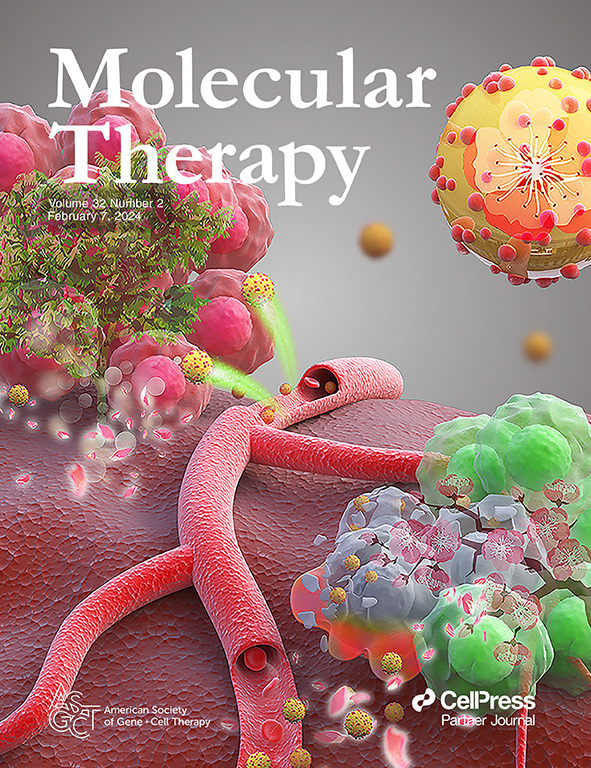足细胞导向的VEGFC基因治疗可防止1型糖尿病小鼠模型肾小球通透性增加和糖萼损伤。
IF 12
1区 医学
Q1 BIOTECHNOLOGY & APPLIED MICROBIOLOGY
引用次数: 0
摘要
糖尿病肾病(DKD)是终末期肾衰竭的主要原因,目前的干预措施不能直接针对肾小球,而肾小球是疾病的起始点。血管内皮生长因子(VEGF)C是肾小球内皮屏障功能的关键贡献者。在转基因小鼠中,足细胞特异性过表达人VEGFC对早期DKD具有保护作用。在这里,我们研究了足细胞靶向VEGFC基因治疗DKD的治疗潜力。我们采用腺相关病毒载体(AAV2/9)在人和小鼠足细胞中驱动人VEGFC。体外表达的VEGFC具有功能。在1型糖尿病小鼠(链脲佐菌素诱导)中,全身给药AAV2/9增加肾小球人VEGFC表达,改善蛋白尿和增加肾小球通透性。重要的是,VEGFC基因治疗还可以保护肾小球内皮糖萼,这是肾小球滤过屏障中蛋白质的第一个屏障。这些发现表明足细胞导向的VEGFC基因递送可以恢复肾小球功能并防止早期DKD进展。这种新方法代表了一种很有前景的治疗策略,特别是对于有DKD风险的1型糖尿病患者,那里有未满足的临床需求。本文章由计算机程序翻译,如有差异,请以英文原文为准。
Podocyte-directed VEGFC gene therapy prevents increased glomerular permeability and glycocalyx damage in a mouse model of type 1 diabetes.
Diabetic kidney disease (DKD) is the leading cause of end-stage renal failure, and current interventions fail to directly target the glomerulus, where the disease initiates. Vascular endothelial growth factor (VEGF)C is a key contributor to glomerular endothelial barrier function. In transgenic mice, podocyte-specific overexpression of human VEGFC was protective in early DKD. Here, we investigated the therapeutic potential of a podocyte-targeted VEGFC gene therapy in DKD. We employed an adeno-associated virus vector (AAV2/9) to drive human VEGFC in human and mouse podocytes. Expressed VEGFC was functional in vitro. In type 1 diabetic mice (induced by streptozotocin), systemic administration of AAV2/9 increased glomerular human VEGFC expression, ameliorating albuminuria and increased glomerular permeability. Importantly, VEGFC gene therapy also protected the glomerular endothelial glycocalyx, the first barrier to protein in the glomerular filtration barrier. These findings demonstrate that podocyte-directed VEGFC gene delivery can restore glomerular function and protect against early DKD progression. This novel approach represents a promising therapeutic strategy, particularly for patients with type 1 diabetes at risk of DKD, where there is an unmet clinical need.
求助全文
通过发布文献求助,成功后即可免费获取论文全文。
去求助
来源期刊

Molecular Therapy
医学-生物工程与应用微生物
CiteScore
19.20
自引率
3.20%
发文量
357
审稿时长
3 months
期刊介绍:
Molecular Therapy is the leading journal for research in gene transfer, vector development, stem cell manipulation, and therapeutic interventions. It covers a broad spectrum of topics including genetic and acquired disease correction, vaccine development, pre-clinical validation, safety/efficacy studies, and clinical trials. With a focus on advancing genetics, medicine, and biotechnology, Molecular Therapy publishes peer-reviewed research, reviews, and commentaries to showcase the latest advancements in the field. With an impressive impact factor of 12.4 in 2022, it continues to attract top-tier contributions.
 求助内容:
求助内容: 应助结果提醒方式:
应助结果提醒方式:


